You’re tired of watching your plants wilt while your water bill skyrockets, but expensive irrigation systems aren’t in your budget. The good news? You don’t need to spend hundreds of dollars to keep your garden thriving. From simple gravity-fed solutions to clever DIY setups, there are proven watering systems that’ll transform how you care for your plants without breaking the bank. The secret lies in choosing the right method for your specific situation.
Drip Irrigation Systems: Water-Saving Champions
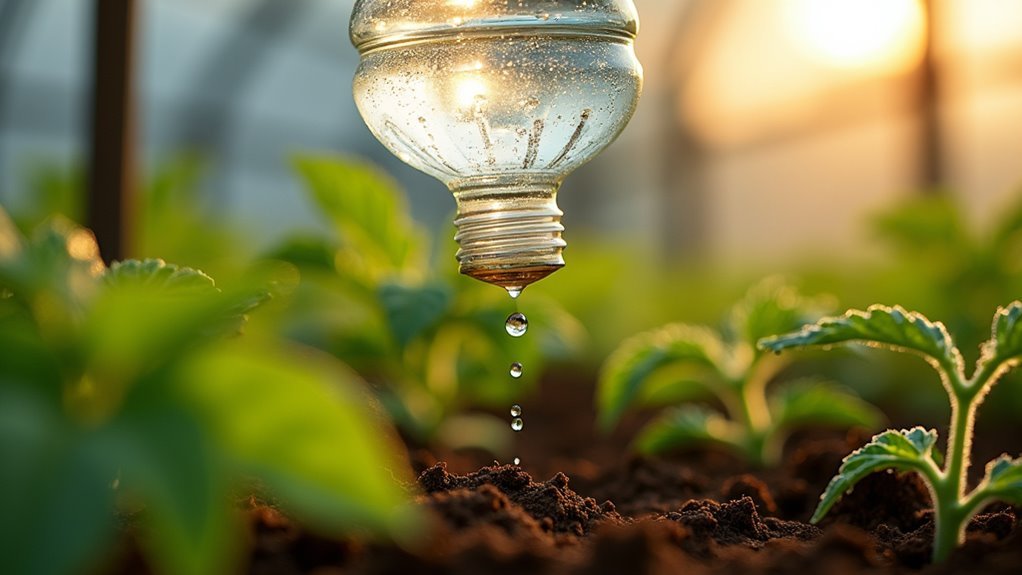
Few watering methods can match the efficiency of drip irrigation systems when you’re looking to maximize every drop while minimizing your budget.
These systems deliver water directly to plant roots through tubes and emitters, achieving remarkable water efficiency by reducing consumption by 60-80% compared to conventional methods. You’ll appreciate that a basic setup costs around $100 and covers up to 1,000 square feet effectively.
Your investment pays off through superior water conservation and reduced maintenance. The system prevents weed growth and foliar diseases by avoiding water splash on leaves.
Drip irrigation delivers exceptional returns through water conservation, reduced maintenance, and healthier plants by eliminating leaf splash and weed promotion.
With a pressure regulator, you can customize flow rates for different plants’ needs. Components last 5-10 years with proper care, making drip irrigation systems an economical choice that’ll reduce water consumption considerably.
Soaker Hoses: Simple Yet Effective Moisture Delivery
You’ll find soaker hoses offer one of the simplest approaches to efficient garden watering, delivering moisture directly through tiny pores along their entire length.
They’re incredibly easy to install—just lay them 2-3 inches from your plants and cover with mulch for maximum efficiency.
At $20-30 for 50 feet, they provide excellent water savings without breaking your budget.
How Soaker Hoses Work
While traditional sprinklers spray water overhead and often waste precious moisture to evaporation, soaker hoses deliver water directly where your plants need it most.
These innovative tools release water slowly through thousands of tiny pores along their entire length, creating an efficient irrigation system that targets plant roots precisely.
You’ll find that soaker hoses maintain consistent moisture levels without saturating the soil surface or wetting plant foliage.
This targeted approach prevents fungal diseases while ensuring your plants receive steady hydration. Wind won’t affect their performance like overhead sprinklers, eliminating drift and maximizing every drop you use.
The slow, steady flow allows soil to absorb water completely, reducing runoff and delivering water exactly where it’s most beneficial for healthy plant growth.
Installation and Placement Tips
Though soaker hoses seem straightforward to install, proper placement makes the difference between thriving plants and wasted water. Unlike complex drip irrigation system setups, soaker hoses don’t require specialized emitters to guarantee water distribution—their porous design handles this naturally.
Follow these installation and placement tips:
- Position hoses 2-3 inches from plant stems to prevent root rot
- Bury under 2-3 inches of mulch to reduce evaporation
- Space lines 12-18 inches apart for vegetables, 18-24 inches for perennials
- Check for clogs every 2-4 weeks for ideal performance
Connect your hoses to any standard water source, though pressure regulators help maintain consistent flow.
Consider your local weather patterns when scheduling watering times—early morning works best for most climates.
Cost and Water Savings
Setting up your soaker hose system properly pays dividends in both your wallet and water conservation efforts. The upfront cost remains remarkably low, with basic 50-foot systems starting around $20-30. This drip system delivers targeted watering directly to plant roots, eliminating waste from wind drift and runoff.
| Traditional Sprinklers | Soaker Hoses |
|---|---|
| High evaporation loss | Minimal water loss |
| Wet foliage risks disease | Dry leaves stay healthy |
| Uneven water flow | Consistent moisture delivery |
| Higher monthly bills | Reduced water costs |
You’ll notice immediate water savings as the controlled water flow reaches only where it’s needed. By keeping water at soil level, you’re maximizing every drop while protecting your plants from fungal diseases that plague overhead watering methods.
Self-Watering Containers: Perfect for Patio Gardens
You’ll find self-watering containers incredibly practical if you’re working with limited patio space or can’t water daily.
These systems use a built-in reservoir that slowly releases water through wicking action, maintaining consistent soil moisture without your constant attention.
They’re designed to maximize growing space while minimizing maintenance, making them ideal for busy gardeners who want thriving plants in compact areas.
How They Work
While self-watering containers might seem complex, they operate on a surprisingly simple principle that makes plant care effortless for patio gardeners.
These systems deliver water directly to plant roots through consistent moisture delivery, eliminating guesswork from your gardening routine.
Here’s how self-watering containers function:
- Water reservoir system – The 12.7-gallon capacity stores water below the planting area, creating a reliable supply.
- Wicking mechanism – Soil naturally draws water upward as plants need it, preventing over or under-watering.
- Monitoring gauge – You’ll track water levels easily without daily checking.
- Controlled drainage – Built-in systems prevent waterlogging while maintaining ideal moisture.
Unlike traditional drip irrigation kits, self-watering containers reduce daily watering while promoting healthier plants through automated hydration management.
Space-Saving Benefits
Compact living doesn’t mean you’ll sacrifice your gardening dreams when self-watering containers maximize every square foot of your patio space.
These systems transform cramped balconies and patios into productive gardens through efficient use of space that accommodates herbs, vegetables, and flowers in minimal areas.
Your self-watering containers deliver consistent moisture while eliminating bulky watering equipment storage needs.
You’ll create vertical growing opportunities by stacking or arranging multiple containers strategically.
The built-in water reservoirs reduce your daily maintenance time, allowing you to maintain an ideal watering routine without constant monitoring.
This space-saving design promotes healthy plant growth in tight quarters where traditional gardening methods fail.
You’re maximizing productivity per square foot while maintaining the convenience that busy lifestyles demand.
Micro-Sprinkler Systems: Targeted Hydration
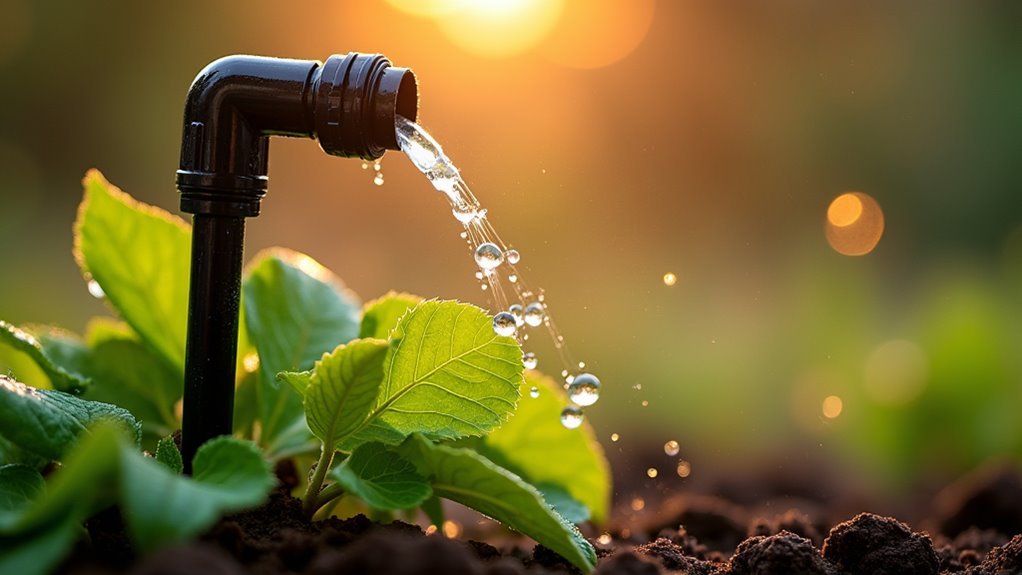
When you’re looking to maximize watering efficiency without breaking the bank, micro-sprinkler systems deliver water directly to your plants’ root zones while cutting water waste by up to 80% compared to traditional methods.
These systems provide targeted hydration through adjustable emitters that you can customize based on your plant spacing and coverage needs.
Key advantages of micro-sprinkler systems include:
- Economical coverage – A $55.99 kit effectively irrigates up to 300 square feet
- Versatile application – Perfect for fruit trees, ornamental beds, and various garden types
- Disease prevention – Minimized evaporation and runoff reduce foliar diseases and weed growth
- User-friendly design – Simple installation and maintenance for all gardening experience levels
You’ll achieve healthier plant growth while enjoying straightforward installation and maintenance that makes these systems practical for any budget-conscious gardener.
Wicking Bed Systems: Sub-Surface Irrigation Excellence
Beyond surface-level watering solutions, wicking bed systems harness the power of capillary action to create a self-regulating irrigation method that delivers water directly to your plants’ root zones from below.
This cost-effective option requires just a water-tight container and gravel reservoir, making construction possible for under $50. You’ll achieve efficient moisture retention while reducing water usage by up to 70% compared to traditional methods, promoting significant water conservation.
These systems maintain consistent moisture levels, requiring watering only once every 3-7 days even during hot conditions. The sub-surface irrigation design eliminates constant attention while ensuring your plants receive ideal hydration through natural capillary action.
Rain Barrel Gravity Systems: Eco-Friendly Irrigation
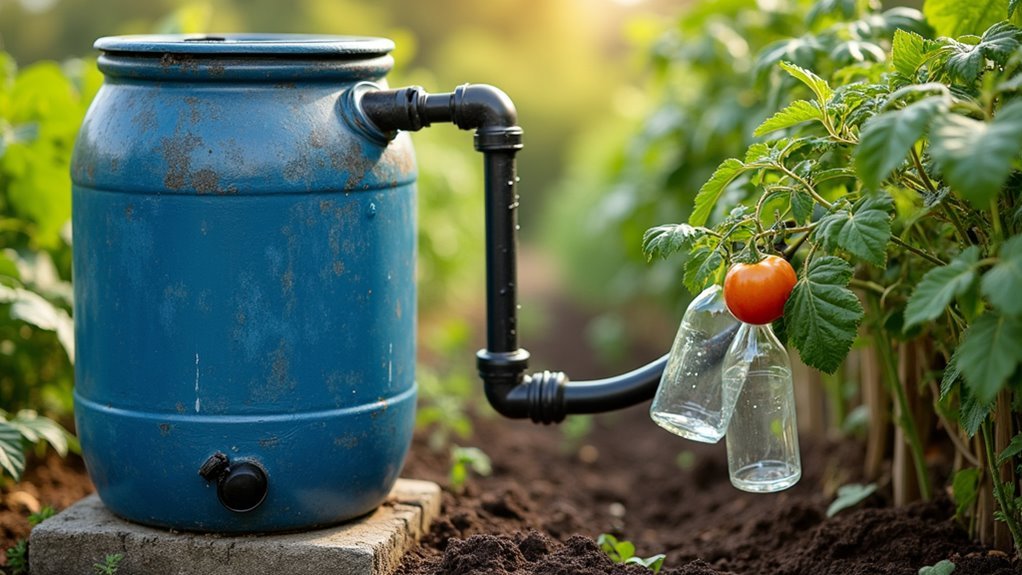
Harnessing nature’s free water supply, rain barrel gravity systems transform rooftops into irrigation resources by capturing and redirecting runoff that would otherwise flow into storm drains.
You’ll position your rain barrel beneath a downspout and elevate it to create natural water pressure that flows directly to your plants.
Setting up effective eco-friendly irrigation requires these essential components:
Four key elements form the foundation of any successful rain barrel gravity irrigation system for your garden.
- Elevated positioning – Height creates gravity pressure for consistent water flow
- Mesh screening – Prevents debris entry and blocks mosquito breeding sites
- Downspout connection – Channels rooftop runoff directly into storage
- Distribution system – Connects to drip irrigation or soaker hoses for coverage
These gravity systems reduce reliance on municipal water while supporting sustainable gardening practices.
You’ll slash water bills considerably while maintaining healthy plants using nature’s free irrigation solution.
Smart Sprinkler Systems: Technology Meets Gardening
Although traditional sprinklers operate on fixed schedules regardless of weather conditions, smart sprinkler systems revolutionize garden irrigation by connecting to your home’s Wi-Fi network and adapting automatically to environmental changes.
You’ll control watering schedules remotely through smartphone apps, making gardening technology accessible for busy lifestyles.
These systems slash water consumption by 30-50% compared to traditional watering methods by adjusting timing based on weather forecasts. You won’t waste water during rainy periods anymore.
Customizable settings let you tailor irrigation to specific plant needs and garden layouts, ensuring targeted hydration where it’s needed most.
While basic models start around $100, the reduced water usage typically offsets initial costs through lower utility bills and decreased maintenance expenses over time.
Frequently Asked Questions
How to Build a Simple Plant Watering System?
You’ll need 1/4 inch soaker hoses, measure and cut tubing for your garden layout, position hoses 2-3 inches from plant stems, add adjustable emitters, and incorporate a timer for automation.
What Is the Cheapest Irrigation System?
You’ll find soaker hoses are the cheapest option, starting at just $20-30 for fifty feet. They’re perfect for small gardens and deliver consistent moisture directly to your plants without fancy equipment.
Are Ollas Better Than Drip Irrigation?
You’ll find drip irrigation outperforms ollas for most gardens. It’s more water-efficient, lasts longer, and works with diverse plants. However, ollas work better if you’re seeking simple, low-tech solutions for small spaces.
How Do You Water Outdoor Potted Plants When Away for a Week?
You can use DIY drip irrigation with timers, insert inverted water bottles into soil, group plants together for moisture sharing, or set up wicking systems to keep your potted plants watered.

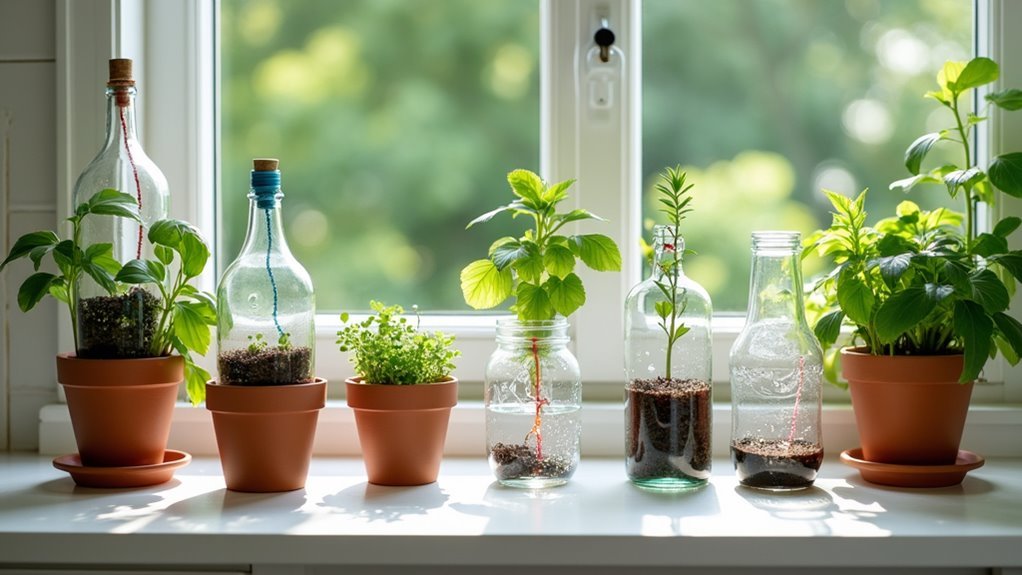

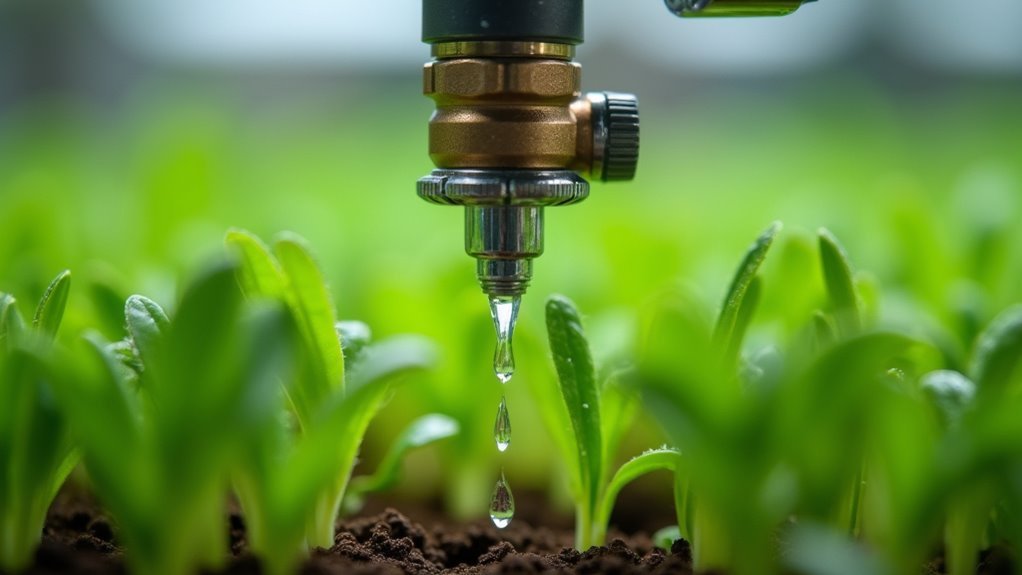
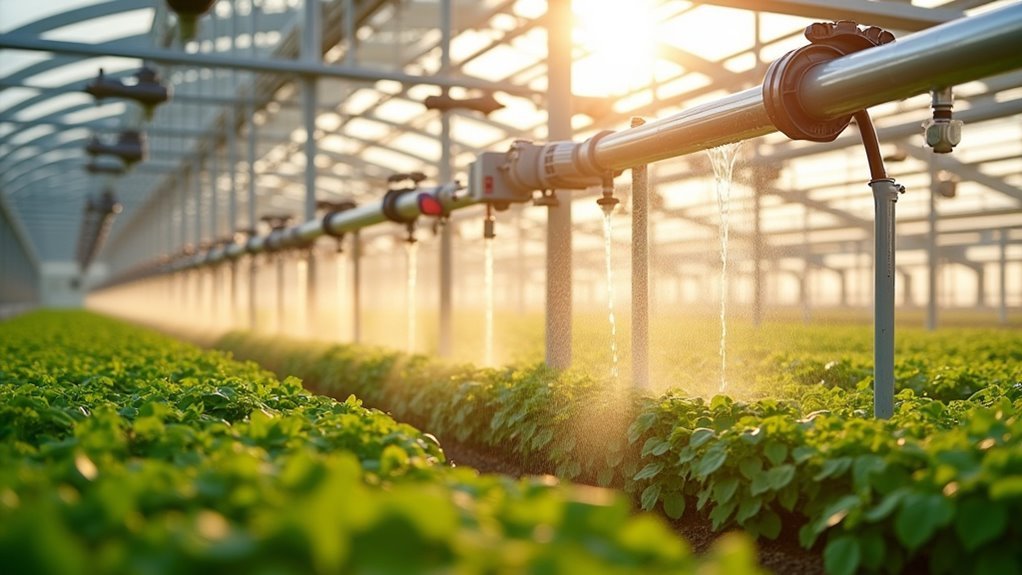
Leave a Reply